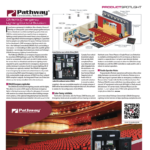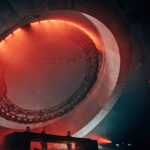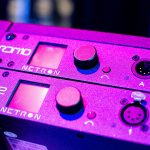When Cast Software launched WYSIWYG, a lighting-only design software tool, in 1994, it was new, innovative and the only one of its kind. Today, there is no shortage of competition for the Toronto-based company, but that hasn’t slowed them down. And now, they have supplemented their offerings to cover new segments within the entertainment industry. As of September 2005, WYSIWYG, which is now being called a “Production Design Suite of Tools,” delivered Release 14, which, among other things, adds the ability to showcase all types of video content in the 3-D virtual world. Cast continues to crank out new software updates on an aggressive three-month schedule aimed at fulfilling the longterm vision of creating a fast, easy solution to all production designs. The latest update, Release 16, introduces “moving scenery.”
What It Is
For the uninitiated, WYSIWYG is an integrated design and visualization tool based on a proprietary 3-D CAD engine and a variety of tools to aid in the production process. It allows you to easily build a 3-D black box, arena or proscenium arch space with the venue wizard, or you can import a 3-D model as a *.dxf or *.dwg file. Alternatively, you can build a set using the CAD tools. It has an extensive library of real-world fixtures, truss, props and accessories that might be the most inclusive in the industry. By inserting objects from the library, it’s very easy to create a lighting and/or set design. The lighting instruments can be numbered sequentially with a single click and the properties of each instrument can be edited to assign DMX addresses, dimmer channels, gel colors, gobos and accessories. You can then plot your design and customize the data associated with the instruments in order to present the most clear and concise layouts.
When you’re ready to massage the paperwork, you can use the Data Mode of the software suite to pull up a spreadsheet with an assortment of data. The hard-working library meisters at Cast Software have already accurately modeled the fixtures in the library, so they come preloaded with data, including every software release and mode available for automated lights and LED fixtures. It also includes lamp types, fixture weight and a lot more. So when you move into the Data Mode, you get a spreadsheet with 34 columns of data, much of it already completed by the time you click on the Data tab. You can export it as a generic spreadsheet and edit it to your heart’s content, helping you to do electric load calculations, weight load calculations, circuiting, shop orders and much more. There is also a free viewer that you can download from the Cast Web site so you can print plots and rental orders.
When it comes time to sell your design, you can go into the design mode and build looks by creating focus positions, turning on lights and assigning intensity, color, gobos, zoom, iris and prism effects without having to patch or use a lighting console. You can also use the materials library to map a material to any object, which creates a more realisticlooking object. As you finish a scene, you can use the render wizard to output a bitmap of a photorealistic picture that you can then use to sell your design. You can choose the size of the bitmap file in pixels so that you can create an image with the right resolution.
One of the best features of WYSIWYG is the real-time visualization windows that allow you to use a console or an offline editor to preprogram a show virtually in live mode. You can also load the offline editor from a console manufacturer on the same computer on which you are running WYSIWYG and link them with the device manager in live mode to be able to visualize the cues and focus positions, color, gobo, intensity and effects as you manipulate them. You can create scenes and record them in the offline editor just as you would in a live situation and end up with an entire show that is pre-cued and very close to being ready. Then, you can bring your show file to the show and touch up the focus positions, and you’ll be virtually dialed in and ready to go. It’s a great time- and money saver, and it allows you more creative freedom in your designs.
The new video streaming feature from Release 14 allows you to stream live or canned video content to a video screen and/or surface, which you can place in your virtual design. With the importance of video in today’s productions, this is a really useful feature. And now, with Release 16, you can visualize moving battens, set pieces or anything that needs to move. For the first time, you can visualize all the lighting, video and motion control in real time together in one software package.
What It Will Be
Cast also has a very active WYSIWYG developers program that allows lighting, video and motion-control manufacturers to simulate their console or server’s output not only individually, but also as a system with the ability to talk back to the controller and instruct it how to manipulate devices. Very soon, these three entities will have the ability to communicate and interact with each other; lights will be able to track sets, sets will avoid lights, video will trigger sets and sets will trigger video displays or locations.
And that’s just the beginning of the updates that are promised in the near term. Soon to come is a new LED fixtures wizard that will simplify the process of patching and programming of complex designs of all LED-based fixtures and screens. Cast has had to redesign and rewrite its library source files to be able to handle the wide variety of LEDs now available in the marketplace, some of which are incredibly challenging to model because of built-in macros and pixel-mapping capability.
And as anyone who has ever had to chase down a fixture profile will testify, keeping a console fixture library up-to-date can be challenging. Later on this year, WYSIWYG will add the ability to download its library fixture profiles directly into any console that can and wants to receive them. You will be able to design your show in WYG and automatically load your patch and fixtures directly into the console. As more of these upgrades are incorporated, the product is moving towards a cohesive solution that encompasses the entire production design process.
WYSIWYG is a PC-based software product designed to run on an average computer. The CAD engine is not as powerful and flexible as some, and there might be the occasional compatibility issue with exports and imports, but most designers will never encounter them. Although there are some more realistic visualizations available, they have much more stringent hardware requirements, and I would venture to say that there are none that are easier to learn and work with. What WYSIWYG lacks in some areas is made up for in scope and flexibility. It’s the type of design tool that no serious designer should be without.
Cast Software
416.597.2278
www.cast-soft.com


